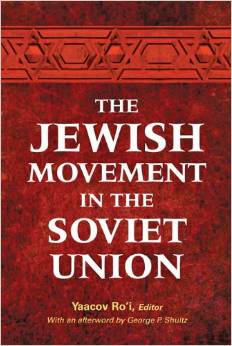Researching Jewish Luck led Leslie and me down many academic paths as we pieced together the Jewish world of Vera and Alla. If you glance at our extensive bibliography, you’ll discover that we investigated newer academic findings as well as checking sources written before the opening of the Soviet archives in the early 1990s.

When I began to read Yaacov Ro’i’s compilation of 14 scholarly articles in The Jewish Movement in the Soviet Union, I felt like the actor in the V-8 juice commercial—“I shoulda had access to this volume before we began researching!”
I enjoy a good novel, a thrilling mystery and a compelling memoir but I revel in an academic work that clarifies and explains. I raced through the articles soaking in the data and analysis and checking the footnotes to see if Leslie and I had read the same sources. About halfway through the volume, I began to wonder what would happen if the research within this book called into question our conclusions and our data. We can report with relief, that the articles do support our own writing.
The Jewish Movement in the Soviet Union deals primarily with the dissidents and prisoners of Zion rather than the Jews who populated the backdrop. If you’re searching for a book that delves into the how and why of the movement that secured freedom for so many at the cost of many individuals’ personal freedoms, we recommend this anthology.
One of the joys of the articles was reading the selected quotes that, like the epigrams in our book, capture an idea or a feeling. For example, Cantorovich and Cantorovich cite Anna Shternis’s term “kosher pork” to describe the Jewish practices of the pre- World War II Russian Jews. When describing why the USSR did not commemorate the Holocaust as part of the remembrance of WWII, Cantorovich and Cantorovich cited Zvi Gitelman: “The great Patriotic War was too valuable a political asset to be awarded to the Jews.” Juliane Fürst’s quote from Mark Azbel’s memoir applies equally to Vera and Alla. “A Jewish child understands from the start that he is a cripple. But he can’t exactly understand what his handicap is; he can’t figure out wherein he is defective.”
The statistics in the book are the latest available. Statistics about Russian Jews are tricky. When asked how many Jews live in Russia today by an attendee at a book talk, I halted. Did that mean only Jews with two Jewish parents, a Jewish mother, a Jewish father, only Jews that self-identify? And what about the Jews who used to be part of the USSR but now live in Ukraine or Belarus or Georgia? Ro’i provides a comprehensive chart from the Jewish Agency that lists the Soviet emigration numbers from 1968-1991. It affirms our research that Alla’s application for aliyah arrived at OVIR when the Politburo had decided to restrict emigration. That made me breathe a sigh of relief. Edith Rogovin Frankel’s article provides insights into the deliberations of the Communist Party Central Committee as they seek to answer the dilemma, what to do about the Jews?
The afterward by George Shultz turned the focus away from the Soviet actors and onto the US government’s role. It was heartwarming to read of his passionate concern for Soviet Jews but the afterward didn’t seem to fit the book.
We invite you to extend your understanding of the movement of Soviet Jews through this new research. We’re certain that newer research will emerge at some time and we will refine our understanding once again.
Ro’i, Yaacov. ed. The Jewish Movement in the Soviet Union. Wash: Woodrow Wilson Center Press, 2012.